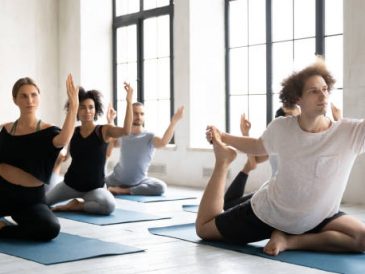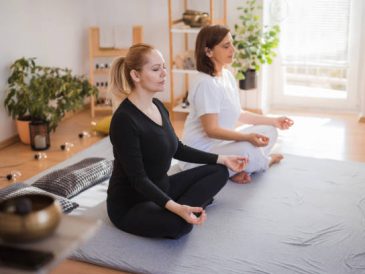Stroke, a leading cause of disability worldwide, often leaves survivors grappling with physical and mental challenges. Traditional rehabilitation methods have shown promise, but emerging evidence suggests that integrating yoga into stroke recovery programs could offer profound benefits. Yoga, with its holistic approach encompassing physical postures, breathing techniques, and mindfulness practices, holds promise as a complementary therapy to aid stroke survivors in reclaiming their quality of life. In this article, we delve into the potential of yoga as the missing link in stroke survivors’ rehabilitation.
Understanding Stroke and Rehabilitation: Stroke occurs when the blood supply to the brain is disrupted, leading to brain cell damage. This disruption can result from a blocked artery (ischemic stroke) or the bursting of a blood vessel (hemorrhagic stroke). Survivors often face a range of challenges, including impaired movement, speech difficulties, cognitive impairments, and emotional disturbances.
Traditional stroke rehabilitation typically involves physical therapy, occupational therapy, and speech therapy aimed at restoring lost function and independence. While these approaches are invaluable, many survivors continue to experience residual deficits, highlighting the need for complementary interventions to enhance recovery.
The Role of Yoga in Stroke Rehabilitation: Yoga, an ancient practice originating in India, offers a multifaceted approach to healing that aligns with the complex needs of stroke survivors. Its components, including physical postures (asanas), breathing exercises (pranayama), and meditation/mindfulness techniques, synergistically address various aspects of recovery.
- Physical Benefits: Yoga postures are designed to improve strength, flexibility, balance, and coordination—all of which are commonly affected in stroke survivors. Modified poses can be tailored to accommodate individual abilities and limitations, making yoga accessible to people with diverse functional abilities. Regular practice can help survivors regain mobility, reduce muscle stiffness, and prevent secondary complications such as contractures and pressure sores.
- Psychological Well-being: The psychological impact of stroke, including depression, anxiety, and diminished self-esteem, is often overlooked but significantly influences recovery outcomes. Yoga’s emphasis on mindfulness and relaxation techniques can alleviate stress, enhance mood, and promote a sense of well-being. Mindful breathing exercises help survivors cultivate present-moment awareness, manage emotional distress, and develop resilience in the face of adversity.
- Cognitive Enhancement: Stroke survivors frequently experience cognitive impairments, such as memory deficits and difficulty concentrating, which can impede functional recovery. Yoga practices that incorporate mindful movement and breath awareness have been shown to enhance cognitive function, including attention, memory, and executive functioning. By stimulating neural plasticity and promoting neurogenesis, yoga may facilitate brain repair and optimize cognitive rehabilitation outcomes.
- Social Support and Connection: Engaging in yoga classes provides stroke survivors with opportunities for social interaction and peer support, fostering a sense of belonging and community. Group-based yoga interventions create a supportive environment where individuals can share experiences, celebrate progress, and draw inspiration from one another. The camaraderie and encouragement within a yoga community can boost motivation and adherence to rehabilitation efforts.
Evidence Supporting Yoga in Stroke Rehabilitation: Research investigating the efficacy of yoga in stroke rehabilitation is burgeoning, with preliminary findings suggesting promising outcomes. Several studies have demonstrated improvements in physical function, balance, gait, and quality of life among stroke survivors participating in yoga interventions. Furthermore, yoga-based interventions have been associated with reductions in post-stroke depression, anxiety, and stress levels.
A systematic review published in the Journal of Stroke and Cerebrovascular Diseases found that yoga interventions significantly improved balance, mobility, and quality of life in stroke survivors. Another study published in the American Journal of Physical Medicine & Rehabilitation reported that a six-week yoga program led to improvements in motor function and activities of daily living in individuals with chronic stroke.
Moreover, emerging neuroimaging studies have provided insights into the neurobiological mechanisms underlying the beneficial effects of yoga on brain structure and function in stroke survivors. Functional MRI studies have shown alterations in brain connectivity patterns following yoga practice, suggesting potential neuroplastic changes associated with improved functional outcomes.
Practical Considerations and Implementation: Integrating yoga into stroke rehabilitation programs requires careful consideration of individual needs, abilities, and preferences. Rehabilitation professionals should collaborate with certified yoga instructors experienced in working with stroke survivors to develop tailored programs that address specific goals and challenges.
Adaptations and modifications may be necessary to accommodate mobility limitations, sensory impairments, and cognitive deficits. Props such as chairs, bolsters, and straps can enhance accessibility and safety during yoga practice. Additionally, caregivers and family members can play a supportive role by participating in yoga sessions alongside survivors or assisting with home practice.
Yoga offers a holistic approach to stroke rehabilitation that addresses the physical, psychological, and cognitive dimensions of recovery. By integrating yoga into traditional rehabilitation programs, clinicians can enhance the effectiveness of interventions and improve outcomes for stroke survivors. As research in this area continues to evolve, yoga may indeed prove to be the missing link in optimizing stroke rehabilitation and promoting long-term recovery and well-being.




